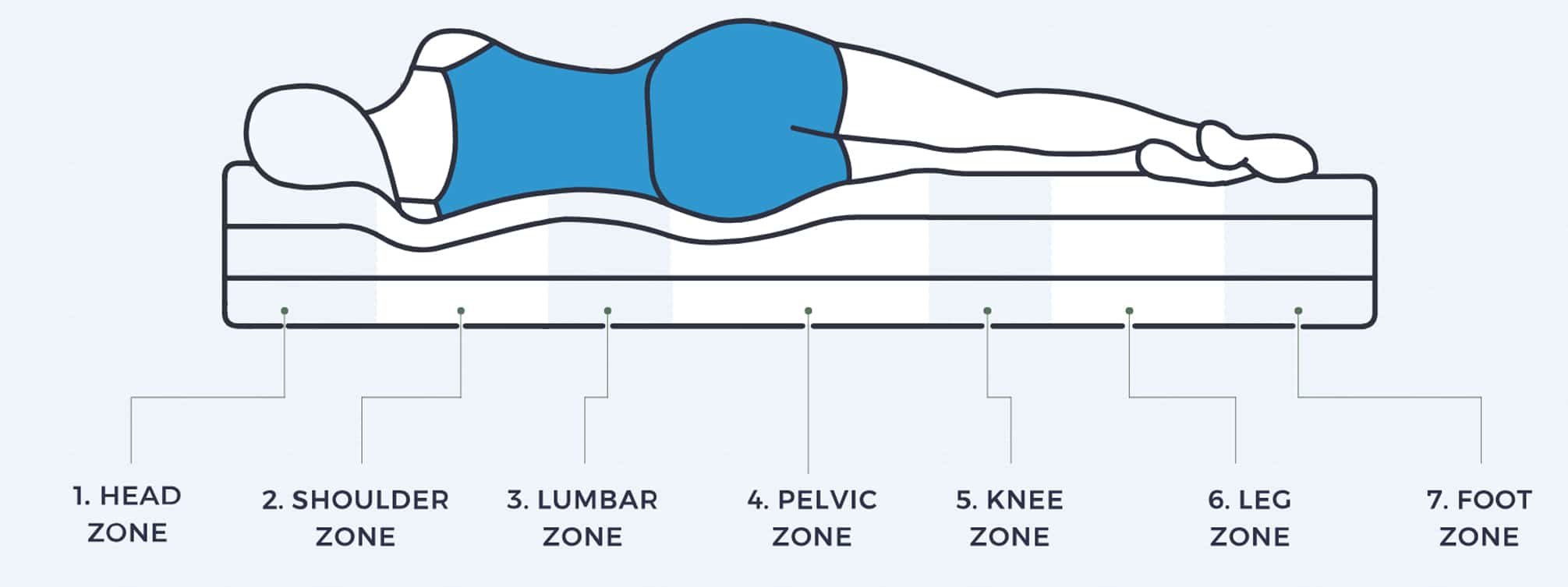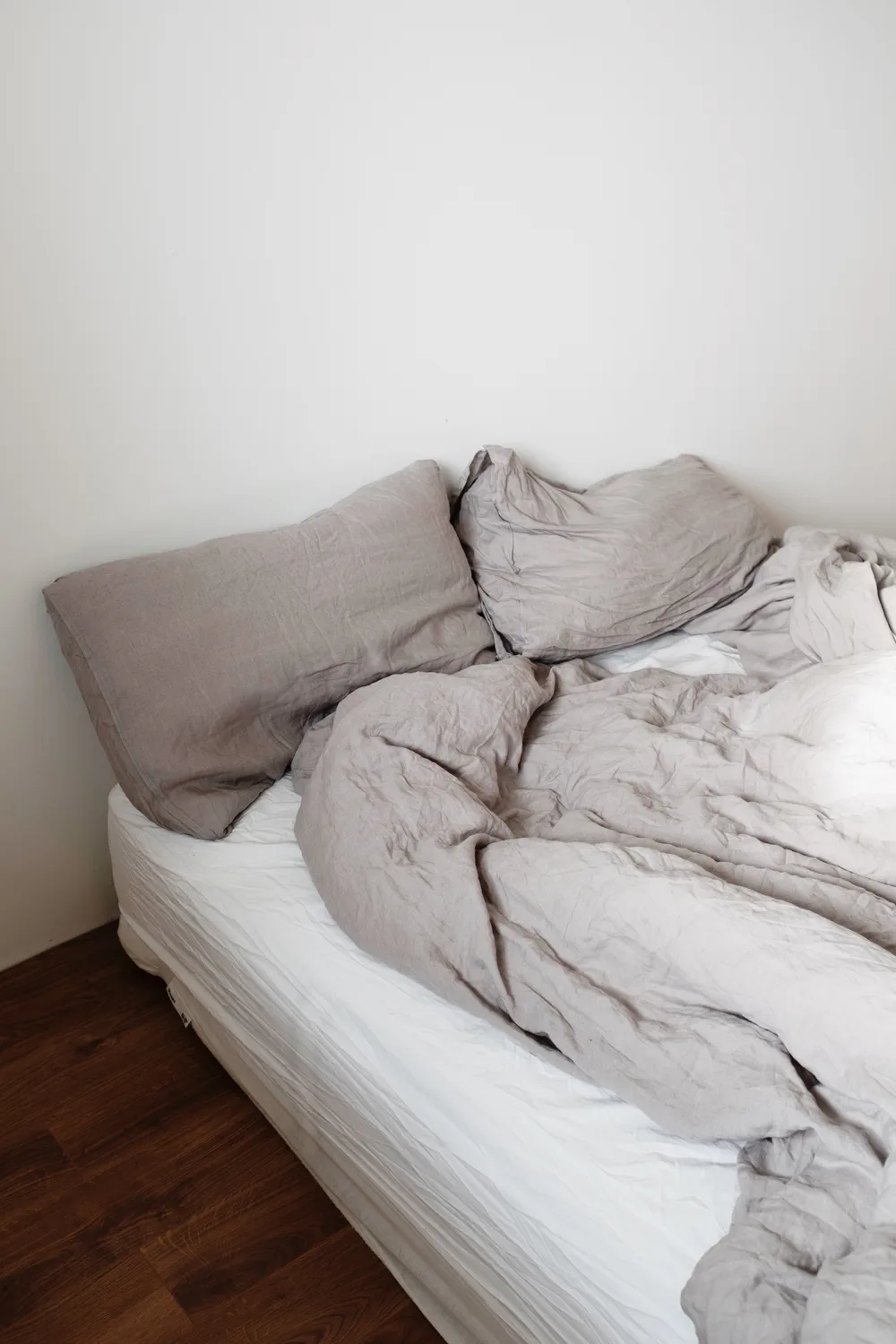Latex Mattress Guide – How Do They Compare to Memory Foam?
Thinking about buying a latex mattress, but not sure how they compare to other types of mattresses? In this latex mattress guide, we explain everything you need to know about how they’re made, their biggest benefits, and whether they’re better than memory foam.
What is a latex mattress?
While you could opt for memory foam, innerspring, or hybrid versions, today we’re going to focus most of our attention on latex mattresses. Mattresses made with properly sourced natural latex can be a great long-lasting option that’s well worth the money and investment.
You can browse the range of Una Mattress organic, natural latex mattresses here.

How is a latex mattress made?
A latex mattress consists of latex foam working alongside springs or reflex foam, with 2 common methods of manufacturing:
Dunlop – In one continuous pour, the latex fills the pre-designed mould. This process creates a firm bottom and softer top to the mattress, ideal for pressure and pain relief.
Talalay – This process is more complicated, involving more steps and other ingredients. The latex is poured partially, before being frozen in a vacuum to expand into a complete foam. This process allows the latex mattress to be less dense and more consistent throughout.
Latex mattresses are made primarily with natural latex, synthetic latex, or a hybrid of both materials.
What is natural latex?
Natural latex is found most commonly in rubber trees – it is the type of latex Una Mattress use. Latex is created by plants as a barrier to protect themselves against injury and insects.
Natural latex mattress brands harvest latex from trees by slitting the bark and allowing the latex to seep out of the tree, similar to the process of tapping maple trees.
After that, the process of processing the latex depends on the natural latex mattress brand. Some brands add chemicals, which can cause allergies, while others use only organic and natural ingredients to create the result you find in your mattress.
What about synthetic latex?
Synthetic latex uses chemicals to create a material similar to natural latex. Typically, synthetic latex mattresses have a more distinct smell, and can cause an allergic reaction for some people.
Synthetic latex is made from two petroleum-based compounds, styrene and butadiene.
Styrene is a toxic chemical that can cause:
- Effects on the central nervous system (CNS)
- Headache, fatigue, weakness, and depression
- Hearing loss
- Peripheral neuropathy
- An increased risk of leukaemia and lymphoma
Butadiene isn’t very much better. It can affect the central nervous system, irritate skin and eyes, and contribute to causing cancer.
Unfortunately, synthetic latex is way cheaper to manufacture than natural latex. It would be easy for unscrupulous mattress manufacturers to mix synthetic latex with natural latex and market the hybrid as “natural latex” at an increased cost to the buyer. Yikes!
The majority of latex mattresses on the market are made with petroleum to create synthetic latex foam. This man-made synthetic, already environmentally unfriendly, also releases unnatural and unhealthy fumes into the air. This can result in disturbed sleep, especially at the beginning before the mattress has had enough time to properly air out.
You can find out more about non-toxic mattresses in this dedicated blog post here.
What is memory foam?
Memory foam was first designed for aeroplane seats in the 1960s. It is made with polyurethane foam and other chemicals to make it more responsive.
The resulting viscoelastic foam conforms to pressure or body heat but bounces back to its original shape when pressure is removed. The heat from your body softens it at appropriate points when you sleep and conforms to the curves and lines of your body. It would suit those that prefer a softer sleeping surface.
Foam is not a natural material and cannot be manufactured without the use of chemicals. While they are not 100% natural, many mattresses are eco-friendly and free of harmful chemicals, VOCs or flame retardants.

Latex Mattress vs Memory Foam Mattress
Those who prefer latex are usually looking for a mattress with more bounce, a faster response time and a more generalized compression. Foam contours to your body, moulding it to your shape and giving the feeling of “sinking” into bed.
You aren’t going to sink into a latex mattress like you might with a foam or hybrid mattress, but it’s also not going to feel like sleeping on a stiff board. The natural latex material provides a cushy and bouncy softness that is also firm, and many latex mattress brands provide a cover that allows you to tweak the firmness to your liking!
Latex allows sinkage and general compression, preventing the “stuck” or overly-enveloped feel that can sometimes accompany memory foam.
Temperature regulation: Memory foam mattresses tend to hold in heat more than latex mattresses. Latex mattresses tend to have better cooling, which is key for hot sleepers.
Bounce: Latex mattresses tend to be much bouncier than memory foam mattresses.
Support: Memory foam mattresses tend to slowly contour to your body, essentially “memorizing” your body’s shape to provide customized support. On the other hand, latex mattresses provide more generalized compression around the body.
While some love the feel of memory foam “hugging” your body as you sleep, others feel kind of “stuck” in one place in memory foam beds, making latex mattresses a better option that still provides the support and compression needed to manage or prevent pain.
Latex Mattress Benefits
1. Eco-Friendly One of the benefits of natural latex mattresses specifically is that most are considered biodegradable. Mattresses made from polyurethane and memory foam can emit toxic chemicals while wasting away in a landfill, whereas latex mattresses slowly break down over time.
These eco-friendly mattresses are not only good for the environment but are made to meet the highest GOLS (Global Organic Latex Standards) certification standards. GOLS only ever certifies latex that comes from sustainable and eco-friendly growth practices.
2. Hypoallergenic and Antimicrobial Can you imagine being allergic to your own home? According to a study by AllergyUK, 3 out of 4 people who suffer from allergies have symptoms in their own bedrooms.
Mold, mildew, dust mites and other nasties love mattresses and bedding. Dust mites, one of the leading causes of bedroom allergies, are microscopic bugs that live in our bedding, mattresses, pillows and carpets. One study of several foam mattresses found that any used mattress can have up to 10 million dust mites in it!
Latex is naturally antimicrobial, repelling harmful organisms and making it an excellent choice for people with sensitive skin and allergies.
You can find out more about anti-allergy mattresses in our dedicated blog post.
3. Naturally Flame Retardant Unlike other mattress materials, latex is naturally fire-resistant, which means that most all-latex mattress brands do not need to add toxic flame retardants to the mattress for safety reasons.
4. Breathable The core of a latex mattress has tiny holes or perforations that are added in the manufacturing process. This is to keep the heat flow through the latex consistent when baking. Unlike traditional foam mattresses, natural latex has an open-cell structure, effectively permitting constant airflow.
Latex also has an open-cell structure that permits constant airflow, especially if other breathable materials like wool and cotton are used for covers. Great for those that like to sleep cooler!
5. Durable Latex mattresses tend to be much more durable than other mattress types. Natural latex mattresses have an average lifespan of 12-20 years, while foam mattresses last about 5-7 years. Rubber is a strong, resilient material that naturally rebounds once pressure is removed and can retain its original shape over many years of use.

6. Joint Support Latex mattresses are known to help relieve pressure points and assist with pain prevention, especially as it relates to joint pain and lower back pain. The firm yet bouncy nature provides support with just the right amount of give.
7. Reduced Motion If you sleep with a partner (or even a furry friend – we don’t judge!), you may worry about waking them when tossing or turning in your sleep, or vice versa. Unlike spring mattresses, and even some memory foam or hybrid mattresses, latex mattresses are not as sensitive to motion. If you move about in your bed, your partner or pet is not likely to notice!
Latex Mattress Disadvantages
Too firm: For some people, latex mattresses may be too firm. However, this really depends on the brand since many latex mattress brands offer customizable covers that can soften the bed, or have plush toppers as well.
Imprints: Some have reported seeing an imprint on where they generally sleep, however this is way less common with beds made of 100% natural latex foam, and is seen much more often in innerspring and memory foam beds.
Heat: Some people complain about latex mattresses holding in heat, which is why it’s very important to notice what materials are used in the mattress cover when browsing different latex mattress types.
Smell: You may have heard people mention that latex mattresses have a distinct smell. This is more commonly found in synthetic latex mattresses as natural latex does not emit a smell.
Cost: Latex mattresses generally cost more than foam mattresses, due to the labour-intensive harvesting of natural materials and manufacturing according to strict standards.
Remember to factor in the increased durability of latex and the cost of replacing foam mattresses more regularly. You’ll have to decide this one for yourself!
How long should a latex mattress last?
According to US-based Consumer Reports, when rotated properly, a mattress could last up to ten years, but some mattresses don’t make it that long, depending on the material and quality.
There are several factors that impact how long a latex mattress lasts, including the brand, the type of latex and other materials used, as well as the bodyweight that is regularly resting on the mattress, but generally, a latex mattress can last around 10-12 years as long as you take care of it properly. Many latex mattress brands will offer a warranty to guarantee quality for a certain span of time, some for up to 10 years.
Generally speaking, however, latex mattresses are among the most durable mattress types, often lasting anywhere from 2 to 7 years longer than other mattresses. Some brands claim to last up to 20 years, believe it or not!
Unlike innerspring and memory foam mattresses, which are both known to sag over time, latex mattresses are less likely due to the elasticity of the latex material. Mattresses made from synthetic latex tend to not last as long as mattresses containing natural latex.
There are also several optional things you can do to lengthen the lifespan of your mattress:
- Invest in a high-quality mattress protector to protect your mattress from unexpected spills, sweating, and dust mites.
- Consider purchasing a mattress topper which will add additional padding, comfort, and protection without directly wearing down your actual mattress.
- Keep your bedding clean. Sheets are generally pretty thin, which means sweat and other debris can easily sink into your mattress. It’s recommended that you clean your linens at least once every two weeks or even more often, to help prevent any dirt or debris from reaching your mattress.
- Clean your mattress. We aren’t going to provide instructions as the process of cleaning a mattress varies depending on the brand and materials used. We recommend reaching out to your chosen mattress brand for the best way to clean it.
- Avoid eating in bed. We know it’s tempting to enjoy a morning cup of joe or your favourite snack, but those crumbs and liquids could potentially reach your mattress and cause damage over time.
- Invest in a bed for your pet rather than letting them sleep with you. Pets, just like humans, can cause wear and tear on mattresses.
Where can I buy a latex mattress?
Natural latex mattresses can be very expensive. We love Una Mattress because their mission was to make organic and natural latex mattresses more accessible by cutting out the middleman and providing a mattress-in-a-box option that is delivered straight to you!
Almost all foam mattresses are made from fossil fuel synthetic foams and that comes with a huge carbon footprint. Una’s products are carbon negative and climate-friendly.
The trees that our sap comes from removing more carbon each year than what is needed to make and deliver the mattresses. In addition, we donate regularly to rewilding and reforestation initiatives like treesisters.org.
Why choose an organic latex mattress?
So, if you want a truly natural and fully sustainable latex mattress then you should only consider the organic Gold-Standard. What defines a Gold-Standard latex mattress is that it is organically certified by the Global Organic Latex Standard (GOLS).
This certification relies on not only the mattress remaining 100% natural, but also that organic standards of production and trade are met throughout the manufacturing process.
This procedure guarantees a fair trade and eco-friendly product, whilst maintaining the sap is grown organically without pesticides. All in all, a fully natural, healthy and sustainable product.
You can browse and shop our full range of natural organic mattresses online.

